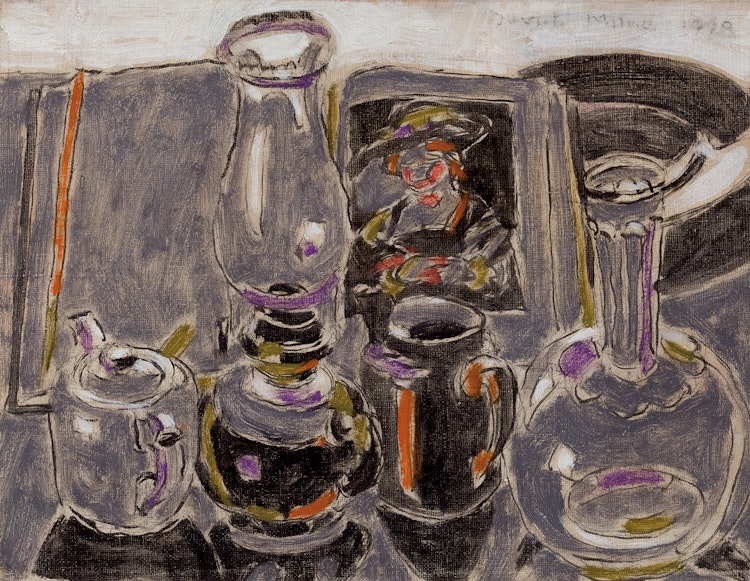Early Morning by David Brown Milne

David Milne
Early Morning
oil on canvas
signed and dated 1928 upper right; titled and dated 1928 on the reverse; catalogue raisonné no. 207.109
12.75 x 16.25 in ( 32.4 x 41.3 cm )
Auction Estimate: $50,000.00 - $70,000.00
Price Realized $144,000.00
Sale date: May 30th 2024
Collection of the Artist
The Rt. Hon. Vincent Massey, Port Hope
Mellors Gallery, Toronto
Private Collection
Blair Laing, Toronto
Private Collection, Florida
Master's Gallery, Calgary
Private Collection, Calgary
"Exhibition of Paintings by David B. Milne", Mellors Galleries, Toronto, no. 21; travelling to James Wilson and Co., Ottawa, November–December 1935
"Exhibition of Paintings by David B. Milne", Toronto, 1935, no. 21, page 2
David Silcox, "Painting Place: The Life and Work of David B. Milne", 1996, page 179 listed as a masterpiece
David Milne Jr. and David P. Silcox, "David B. Milne: Catalogue Raisonné of the Paintings, Volume 1: 1882–1928", Toronto, 1998, reproduced page 443, no. 207.109
Modest only in scale, this is nonetheless an ambitious and masterly painting. Simple domestic belongings are arrayed on a black, reflective surface. A lamp, vase, and two containers stand in a line across the front. In the shallow background are two more items, a plate and a book. The mirroring of the four elements in the front is achieved with great simplicity yet is remarkably true for the eye. Milne was creating similar mirror effects in landscapes of local lakes at this time. Here, the tall, transparent necks of the lamp and vase stretch the image upwards and also help us perceive depth as we see through them to the table beneath. Milne integrates all parts of his shallow space eloquently with the repeating orange vertical lines of one page of the open book, which is echoed on one side of the black vessel between the lamp and vase. Flecks of purple accomplish the same end. The painting is satisfying to a viewer’s gaze in its domestic familiarity, its effortless complexity of form, and in its ultimately cerebral nature.
Does it surprise us to see a book open to an illustration of Flemish master Peter Paul Rubens’ famous "Portrait of Susanna Lunden(?) ('Le Chapeau de Paille')", probably 1622-25, in the National Gallery, London, UK? In Milne’s still life, we cannot make out any of the notable qualities of this painting, but it is clearly identifiable as this Rubens. Milne described Old Master techniques in a letter to his patron and friend James Clarke at about this time. And Milne was in Britain near the end of World War I, eventually painting for the War Records Office. Did he see this painting in situ? Likely not, since the National Gallery was closed at the time. Either way, it is shown here in (now double) reproduction, the way so many 20th-century artists accessed the art of the past. Milne’s allusion to Rubens underlines the casual self-awareness and self-confidence of "Early Morning". It is, of course, not a self-portrait, but it is a depiction of Milne’s formal and historical priorities and of his aspiration to paint meaningfully in the long European tradition.
Mark A. Cheetham has written extensively on Canadian artists, including Jack Chambers, Alex Colville, Robert Houle, and Camille Turner, most recently in the collection "Unsettling Canadian Art History" (2022). He is a freelance writer and curator and a professor of Art History at the University of Toronto.
Share this item with your friends
David Brown Milne
(1882 - 1953) Canadian Group of Painters
Milne was born near Paisley, Ontario. A childhood interest in art, which revived while he was teaching, led him to take a correspondence course and eventually he travelled to New York City to continue his studies. This was somewhat of an exception in the early twentieth-century Canadian art scene as the majority of artists went to Europe to study. While in New York City, Milne worked as a commercial illustrator for several years before deciding to give up this work and devote his time to painting. Shortly after making this decision he moved to Boston Corners in New York.
Throughout his life Milne sought the peace and solitude of a rural life. In his paintings, Milne explored different viewpoints. He greatly admired the work of Tom Thomson but had little interest in the nationalistic approach of the Group of Seven. His themes range from landscapes to views of towns and cities, still lifes and imaginary subjects. His experiments with different media and changing viewpoints show his interest in the process of painting itself. In 1929, Milne returned to settle permanently in Canada, stopping for brief periods in Temagami, Weston, and Palgrave. He built a secluded cabin at Six Mile Lake, north of Orillia, and spent the next six years painting, for the most part, alone. Milne was interested in 'pure' painting, in "adventures in shape, colour, texture and space" as he called his watercolours of the 1930s and 1940s. The change from the less vibrant drybrush "adventures" to the fantasy watercolours is often attributed to the birth of his only child, David Jr., born to Milne's second wife when Milne was sixty. His young son encouraged him to adopt a new, vibrant and often whimsical approach to his art. Milne spent the rest of his life in Uxbridge, north of Toronto, exploring the Haliburton and Bancroft areas as well as the city of Toronto.

